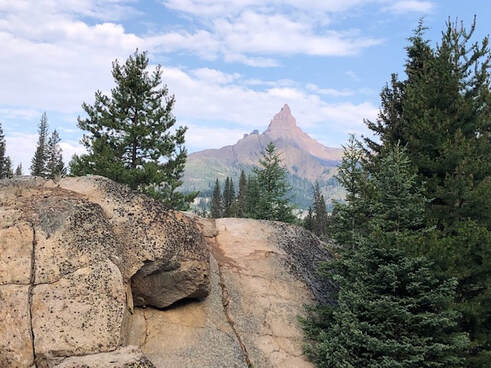|
This week, I would like to compare two essays that I recently came across…
I am currently in Maine dealing with recovery from a broken leg and I am unable to do much activity at the moment. So I have been spending a lot of my time at the beach. Yesterday was forecasted to be a sunny day, however, it wasn’t. At first glance marine fog seemed to be the culprit (which is normal for this area). When I first stepped outside, however, it was like Bozeman in August (which is not normal.) It was smoke from western wildfires, something I have not seen here before. This smoke pouring in from home in Montana offered me a bizarre feeling of connection 2,500 miles away. This got me thinking about our connection as a society to our home planet. We don't think about: where our food comes from, how our actions affect other people (and species) and how frivolous usage of finite resources can cause chaos. It is so easy to forget the fragility of our home… In life, we seem to go through without much thought to details. In the essay “The Etiquette of Freedom,” Gary Snyder attempts to use subtle language to teach a new understanding of wildness as it applies to human nature. To fully understand the message, attention must be given to Snyder’s word pairings and definitions which should make us consider details in order to rebuild our idea of wilderness, not as a place- but as a spiritual mindset and a way of life. Such comprehension takes thought to the subtle and deliberate choice of words that Snyder uses within the text. It does not take Snyder long to start using this intentional language. His title “The Etiquette of Freedom,” seems like a contradicting statement. People often like to think of freedom as a wild and unrestrained entity. However, etiquette may remind us of rules such as “no elbows on the dinner table”- it is almost a rulebook on life. We have to think, what does he mean? Before we understand freedom via wildness, there must first be an understanding of wild and wilderness the way Snyder intends it to be. Snyder says, “Although nature is a term that is not of itself threatening, the idea of "wild" in civilized societies… is often associated with unruliness and disorder” (Snyder, 5). He then calls nature “whole” as it possesses all that is true and right in the world. This is a very substandard way of thinking due to the roots of our view on nature. Throughout the creation of the New World, really up until the romantic period in the 18th century, the wilderness was seen as a dark place where demons lived. Even further, nature was seen as ugly. For example, mountains were seen as blemishes on Earth. This kind of thinking is still very much intertwined within our world today. People are frightened by the freedom and lack of restraints within the wilderness and being wild. We have taught ourselves that everything must have restraints, even freedom. Without the constant judging of society, we have separation anxiety from what we consider to be the correct way to act within human skin. Diverging from these ways is extremely important for a complete human experience. How can someone embody a wild person if they are stuck in their head about how to be acting? Stripping away what has been taught in every lesson since birth is so hard, and probably terrifying for many. Nature and wilderness is seen as something humans can not fully comprehend nor experience. Perhaps, in this day and age this is true. Nevertheless, as Snyder points out, humans are a product of nature (Snyder, 12). For instance, the land Manhattan sits upon was once a swamp, and around it were tribes such as the Mohonk Indians. These Indians lived in the wilderness very similar to the ways other species do today. Snyder asks, why can we not be reinstated as wild beings? The separation from our true beginnings in which we have drifted so far away from, must be identified. Snyder is not the only one to indicate the detrimental weight society can have on people today. David Thoreau, who many know as a master of naturalist writing, wrote an essay titled Walking that touches upon many of the same topics. Thoreau also talks about wilderness and being wild within a new light. He seems to imply that wilderness and wildness is not a place but a mindset- a liberation from the process of life that we know all too well. Thoreau hints that through walking we will have the ability to connect with our innate wildness. Thoreau so eloquently summed up this lack of connection within Walking. “I who cannot stay in my chamber for a single day without acquiring some rust, and when sometimes I have stolen fourth for a walk at the eleventh hour of four o’clock in the afternoon, too late to redeem the day, when the shades of the night were already beginning to be mingled with the day-light-have felt as if I had committed some sin to be atoned for, I confess that I am astonished at the power of endurance- to say nothing of the moral insensibility of my neighbors who confine themselves to shops and offices the whole day for weeks and months, aye and years almost together” (Thoreau, 187-188). There is not a single person who has worked an entire day indoors and has not felt the rust that Thoreau felt. This robotic act of filing paperwork is exactly the opposite of how humans were meant to interact with the world- thus we must combat it. Thoreau and Snyder both have a different sense of wildness, one that can not necessarily be explained unless there are external changes. There is a mental and a physical change within both of these two author’s key to finding wilderness. They both recommend an alter in mindset from intrinsic societal norms, encompassing our wild side and of course they stress the importance of walking in nature. Both require a societal amnesia, wiping clear the worn and rusty slate, reconstructing it with the building blocks of our ancestral and wild past. Only then will we regain the ability to understand other species, and likewise- ourselves. Snyder sums this all up nicely… “Practically speaking, a life that is vowed to simplicity, appropriate boldness, good humor, gratitude, unstinting work and play, and lots of walking brings us close to the actually existing world and its wholeness” (Snyder, 23). We must be polite to ourselves in order to make great differences within this world. Snyder attempts to teach us by changing the definitions of common words, only those brave enough to delve deeper into his word choice and meanings will have the ability to grasp these large concepts. Proper etiquette of freedom means that we know: how we stand as animals, how we interact with nature and how we can complete these daring protocols- ultimately changing our way of life. The lost protocol of the wild, according to Snyder and Thoreau can be found- you just have to go for a walk with a wild mind and look for them. Today, as more and more environmental degradation surrounds us, these concepts are vital to our health and wellbeing. A community, or species disconnected from its home will let it burn. Next week, I will be writing my thoughts around factory meat production. However, while on the subject of human—nature connection- I urge you to start thinking about the food you eat. For example: where it came from, who put work into it to create it and where, the amount of water and sunshine it took to be produced? Ask to be a part of or watch a chicken harvest at a farm, or go hunting at some point. I guarantee that connection to the food you eat will only grow. We all know people who struggle with this disconnect of nature. This week, take them for a walk and get them considering reconnection. If you haven’t, read the works of Gary Snyder- he is a genius. Cheers! Brian The two essays discussed: Snyder, G., & Harrison, J. (2010). The etiquette of freedom: Gary Snyder, Jim Harrison, and the practice of the wild. Berkeley, CA: Counterpoint.
0 Comments
Leave a Reply. |
Special EventsRecord your WOD on Beyond the Whiteboard.
Do you need CrossFit or yoga gear? Click on the links below to buy through our GORUCK, Reebok, Rogue or Affiliate share sale programs. These are affiliate links and our gym will be compensated if you make a purchase after clicking on these links.
Check out our Flickr page!
Categories
All
Archives
April 2024
|
True Spirit CrossFit
|




 RSS Feed
RSS Feed

